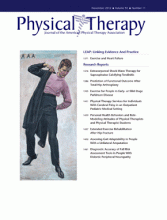Abstract
Background Limited information is available regarding physical therapy use for individuals with cerebral palsy (CP).
Objectives The purpose of this study was to evaluate the association of Gross Motor Function Classification System (GMFCS) level, age, race, sex, and type of insurance with the total physical therapy units received over a 1-year period for individuals with CP in this outpatient pediatric medical setting.
Design This was a cross-sectional study.
Methods Four hundred twenty-five individuals with CP (GMFCS level I, 36%; level II, 15%; level III, 13%; level IV, 19%; and level V, 17%) were identified retrospectively through their electronic medical records. A one-way analyses of variance (ANOVA) was performed for each explanatory variable followed by a multiway ANOVA that adjusted for other variables to find the best model to explain total physical therapy units received.
Results A significant difference in total therapy units received was found among GMFCS levels (F=6.91; df=4,420; P<.001), age groups (F=4.76; df=3,421; P=.028), and type of insurance (F=8.09; df=2,422; P=.004). No significant difference in physical therapy received was found for the factors of sex and race. The final multifactorial model indicates a significant main effect of insurance and a GMFCS by age interaction accounting for 19% of the variability (F=4.45; df=21,403; P<.001).
Limitations This study is cross-sectional and examines physical therapy services received in a pediatric medical setting in 1 geographic region of the United States.
Conclusions The results of this study provide insight into how therapy received varies for individuals with CP. Future studies should evaluate additional variables that may affect physical therapy services received.
Footnotes
Ms Bailes provided concept/idea/research design, writing, data collection, project management, fund procurement, study participants, facilities/equipment, and institutional liaisons. Both authors provided data analysis. Dr Succop provided consultation (including review of manuscript before submission).
The authors thank Michelle Wallace, BS, for her assistance with database management and Kari Dunning, PT, PhD, for her advice regarding study analysis.
This work was partially supported by the Foundation for Physical Therapy Promotion of Doctoral Studies Scholarships awarded to Ms Bailes, 2009–2012.
- Received November 3, 2011.
- Accepted July 11, 2012.












